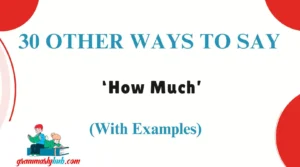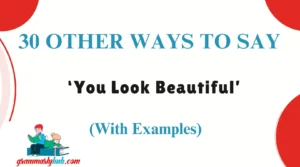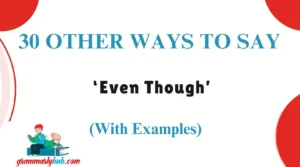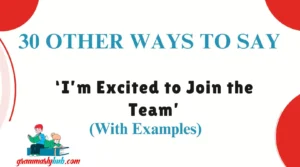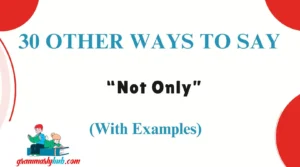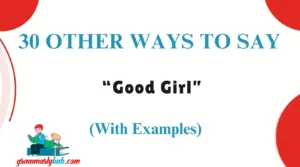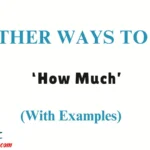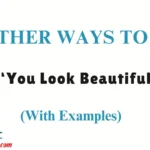Finding the right words to express agreement in a professional and thoughtful manner can make all the difference in how you’re perceived.Whether you’re in a business meeting, writing an email, or engaging in a respectful academic discussion, having a variety of formal alternatives to “I agree with you” helps you sound polished, diplomatic, and sincere.
Below, you’ll find 30 empathetic and intelligent ways to express agreement — with detailed meanings, examples, tone, and when not to use each phrase.
What Does “I Agree with You” Mean?
“I agree with you” means that you share the same opinion or perspective as the other person. It’s a direct way to show support, alignment, or endorsement of their thoughts or actions.
When to Use “I Agree with You”
This phrase (and its alternatives) is best used when you want to:
- Support a colleague’s point of view
- Show alignment in meetings or group work
- Validate someone’s opinion without sounding confrontational
- Maintain professionalism in collaborative settings
Is It Professional or Polite to Say “I Agree with You”?
Yes, but it’s often considered too basic in professional or formal environments. Polished communication benefits from more nuanced expressions that show engagement, critical thinking, or subtle support — especially in written formats.
Pros and Cons of Saying “I Agree with You”
Pros:
- Clear and direct
- Easy to understand
- Friendly in tone
Cons:
- Can sound repetitive or generic
- Lacks depth in formal writing
- Doesn’t reflect critical engagement or reasoning
“I Agree with You” Formally Synonyms:
- I’m in full agreement
- I support that view
- I share your perspective
- I’m aligned with that
- That makes perfect sense
- I’m of the same opinion
- I second that
- That resonates with me
- I concur
- You’re absolutely right
- I stand by that
- I believe you’re correct
- I fully endorse that
- I’m in accord
- I’m with you on that
- That’s a valid point
- I can get behind that
- That aligns with my thinking
- That’s exactly how I see it
- I agree entirely
- I’m on the same page
- I approve of that
- That’s a thought I share
- I find that reasonable
- That’s a point well taken
- That corresponds with my thinking
- I am of like mind
- My thoughts exactly
- I value that insight
- That reflects my view as well
1. I’m in Full Agreement
Definition: I completely agree with what you’ve said.
Explanation: A strong, polished way to confirm full alignment, often used in business meetings or legal discussions.
Example: I’m in full agreement with the direction you’re proposing for the client strategy.
Worst Use: Avoid in personal or casual chats — it may sound too stiff.
Tone: Formal, assured, decisive
2. I Support That View
Definition: I stand behind that opinion or position.
Explanation: A diplomatic and respectful way to show alignment, especially in written communication or group discussions.
Example: I support that view and believe it aligns well with our department’s long-term goals.
Worst Use: Avoid when you need to express enthusiastic agreement — this sounds more reserved.
Tone: Supportive, professional, measured
3. I Share Your Perspective
Definition: I see the situation similarly to you.
Explanation: Ideal for academic, collaborative, or strategic discussions, showing both agreement and intellectual alignment.
Example: I share your perspective on the need for more data-driven marketing decisions.
Worst Use: Don’t use when speed or directness is required — it can sound too elaborate.
Tone: Thoughtful, respectful, collaborative
4. I’m Aligned with That
Definition: I agree and am moving in the same direction as you.
Explanation: This phrase is great for teamwork or project alignment, often used in internal business conversations.
Example: I’m aligned with that and will begin executing it immediately.
Worst Use: Avoid in personal arguments or informal debates — it can sound too technical.
Tone: Businesslike, collaborative, solution-oriented
5. That Makes Perfect Sense
Definition: I completely understand and agree.
Explanation: Shows both comprehension and agreement, often used after someone has explained a complex idea.
Example: That makes perfect sense — thanks for explaining the rationale behind the change.
Worst Use: Avoid using it sarcastically or where tone might be misinterpreted.
Tone: Receptive, respectful, affirming
6. I’m of the Same Opinion
Definition: I hold the same view as you.
Explanation: Formal and academic in tone, suitable for writing or high-level discussions.
Example: I’m of the same opinion regarding the proposed changes to the curriculum.
Worst Use: Too formal for everyday conversations.
Tone: Academic, formal, refined
7. I Second That
Definition: I confirm and back your statement.
Explanation: Common in meetings where someone makes a proposal, and another participant wants to show support.
Example: I second that — it’s time we updated our onboarding process.
Worst Use: Avoid in sensitive discussions — it might sound procedural or emotionless.
Tone: Supportive, meeting-appropriate, structured
8. That Resonates with Me
Definition: I feel a personal or emotional connection to what you said.
Explanation: A great choice when discussing values, mission, or personal growth topics.
Example: That really resonates with me, especially the emphasis on inclusive leadership.
Worst Use: Don’t use it in strictly logical or analytical contexts.
Tone: Warm, empathetic, relatable
9. I Concur
Definition: I formally agree.
Explanation: A short, crisp, and high-level term often used in academic or legal environments.
Example: I concur with your analysis of the financial risks involved.
Worst Use: Sounds cold or robotic in casual or personal conversations.
Tone: Formal, precise, detached
10. You’re Absolutely Right
Definition: You are 100% correct in what you said.
Explanation: Reinforces the correctness of someone’s statement while keeping things professional.
Example: You’re absolutely right — we need to reevaluate our client engagement strategy.
Worst Use: Avoid overuse — it can lose impact or seem ingratiating.
Tone: Confident, validating, strong
11. I Stand by That
Definition: I firmly support that statement or decision.
Explanation: This phrase shows strong alignment and confidence, often used in leadership or decision-making settings.
Example: I stand by that recommendation; it’s in the company’s best interest.
Worst Use: Avoid if you’re uncertain — it implies conviction and commitment.
Tone: Assertive, firm, professional
12. I Believe You’re Correct
Definition: I think your statement is accurate.
Explanation: Slightly softer than “You’re right,” this phrase adds a respectful and intellectual tone.
Example: I believe you’re correct in identifying communication as the root of the issue.
Worst Use: Can sound overly cautious in urgent conversations.
Tone: Respectful, thoughtful, measured
13. I Fully Endorse That
Definition: I completely support that idea or decision.
Explanation: Ideal when expressing strong support for a proposal or strategic initiative.
Example: I fully endorse that approach to improve customer retention.
Worst Use: Avoid in casual discussion — it sounds too executive.
Tone: Formal, enthusiastic, strong
14. I’m in Accord
Definition: I am in agreement.
Explanation: A more literary or academic version of agreement, perfect for formal reports or scholarly work.
Example: I’m in accord with the findings outlined in your report.
Worst Use: Avoid fast-paced verbal communication; it can sound outdated or pretentious.
Tone: Scholarly, refined, elegant
15. I’m With You on That
Definition: I support your view or position.
Explanation: Less formal but still respectful; often used in team environments or supportive collaboration.
Example: I’m with you on that — the proposed workflow needs simplification.
Worst Use: Avoid in highly formal written settings.
Tone: Friendly, cooperative, affirmative
16. That’s a Valid Point
Definition: Your statement is logically sound.
Explanation: A neutral and objective way to show agreement, especially in analytical or critical discussions.
Example: That’s a valid point regarding the risks of early implementation.
Worst Use: Avoid when deeper agreement or enthusiasm is needed — it sounds distant.
Tone: Analytical, professional, constructive
17. I Can Get Behind That
Definition: I support and am willing to back that idea.
Explanation: Slightly informal but still appropriate in relaxed professional environments.
Example: I can get behind that strategy — it’s bold and realistic.
Worst Use: Not suitable for academic or executive-level writing.
Tone: Approachable, motivated, positive
18. That Aligns with My Thinking
Definition: Your idea reflects what I also believe.
Explanation: Useful in collaborative settings where co-creation or joint decision-making is emphasized.
Example: That aligns with my thinking on how to streamline operations.
Worst Use: Too wordy for very fast-paced conversations.
Tone: Collaborative, reflective, professional
19. That’s Exactly How I See It
Definition: My viewpoint matches yours perfectly.
Explanation: A reassuring and confident expression of complete agreement, ideal for alignment in meetings.
Example: That’s exactly how I see it — the timing couldn’t be better.
Worst Use: Avoid repeating it too often — may sound mechanical.
Tone: Strong, supportive, clear
20. I Agree Entirely
Definition: I completely share your view.
Explanation: Straightforward and formal, with a tone of complete acceptance.
Example: I agree entirely with the points you made regarding staff engagement.
Worst Use: Can sound final or closed-off if used in ongoing dialogue.
Tone: Definitive, formal, affirming
21. I’m On the Same Page
Definition: We have the same understanding or agreement.
Explanation: Common in workplace settings to confirm alignment in thought or plan.
Example: I’m on the same page regarding the new implementation timeline.
Worst Use: Avoid in very formal writing — it leans slightly conversational.
Tone: Friendly, collaborative, efficient
22. I Approve of That
Definition: I officially or personally accept that idea.
Explanation: Shows support in a decision-making context, especially from someone with authority.
Example: I approve of that proposal and will submit it to the board.
Worst Use: Sounds too top-down in equal peer conversations.
Tone: Authoritative, formal, affirmative
23. That’s a Thought I Share
Definition: I also think the same way.
Explanation: A warm and introspective way to express agreement during reflective or strategic dialogue.
Example: That’s a thought I share — empathy should be central to leadership.
Worst Use: Too indirect for urgent decisions.
Tone: Warm, thoughtful, reflective
24. I Find That Reasonable
Definition: I believe that idea or statement makes sense.
Explanation: A polite, low-key way to agree without sounding overly enthusiastic — often used in critical discussions.
Example: I find that reasonable given the budget constraints.
Worst Use: May sound lukewarm if strong support is expected.
Tone: Measured, rational, professional
25. That’s a Point Well Taken
Definition: Your comment or argument is understood and respected.
Explanation: A thoughtful way to validate someone’s contribution during discussions.
Example: That’s a point well taken — we’ll definitely consider that in our review.
Worst Use: Avoid very casual chats; it may sound stiff.
Tone: Respectful, acknowledging, moderate
26. That Corresponds with My Thinking
Definition: That matches the way I see things.
Explanation: Formal and intellectual in tone, great for academic or written contexts.
Example: That corresponds with my thinking on ethical standards in marketing.
Worst Use: Too technical for casual conversations.
Tone: Analytical, formal, measured
27. I Am of Like Mind
Definition: I think the same way.
Explanation: A classical and formal expression, especially in scholarly or philosophical writing.
Example: I am of like mind when it comes to investing in long-term innovation.
Worst Use: Sounds archaic in modern business environments.
Tone: Literary, formal, intellectual
28. My Thoughts Exactly
Definition: I was thinking the same thing.
Explanation: A more casual yet polite way to express mirrored thinking.
Example: My thoughts exactly — the policy does need revision.
Worst Use: Avoid in high-stakes writing; it’s too informal.
Tone: Friendly, conversational, quick
29. I Value That Insight
Definition: I appreciate and agree with the idea shared.
Explanation: Blends agreement with appreciation, great for feedback settings.
Example: I value that insight, and I believe it highlights an important gap.
Worst Use: Don’t use it if you disagree even slightly — it may be misleading.
Tone: Affirming, respectful, warm
30. That Reflects My View as Well
Definition: I also hold that opinion.
Explanation: A polished and gentle expression that maintains professionalism and harmony.
Example: That reflects my view as well — prioritizing mental health is essential.
Worst Use: Too passive when strong conviction is needed.
Tone: Polite, diplomatic, affirmative
FAQs: Formal Ways to Say “I Agree with You”
1. What’s the most professional way to say “I agree with you”?
“I concur,” “I’m in full agreement,” or “I fully endorse that” are all excellent formal options.
2. Can these alternatives be used in business emails?
Absolutely. Most of them are tailored for professional communication, especially in corporate, academic, or client-facing emails.
3. Are there polite ways to agree while sounding less direct?
Yes. Phrases like “That aligns with my thinking” or “That reflects my view as well” are gentle yet respectful.
4. What’s a formal way to agree during meetings?
Try “I support that view”, “I second that”, or “You’re absolutely right” — they’re concise and effective.
5. Should I always use formal agreement phrases in professional settings?
Not always. Use judgment — the tone of the environment matters. For informal chats with colleagues, slightly conversational agreement is okay.
Conclusion: Expressing Agreement with Clarity and Care
Saying “I agree with you” is easy — but saying it with grace, precision, and professionalism can elevate your communication. Whether you’re in a boardroom, classroom, or email thread, the phrases above offer thoughtful, respectful alternatives that keep your tone warm and intelligent. Use them strategically to match the tone, setting, and audience, and your message will resonate more deeply every time.

Welcome to GrammarlyHub, your trusted resource for writing clarity, grammar insights, and language tools. Founded by Mia Rose, a passionate writer and language enthusiast, GrammarlyHub is dedicated to helping students, professionals, and creatives write with confidence and precision.


